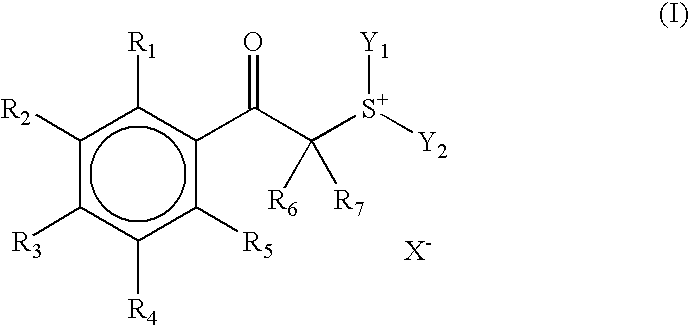Positive photosensitive composition
a composition and photosensitive technology, applied in the field of positive photosensitive compositions, can solve the problems of deterioration of resolution, inferiority of polymers to currently used phenol resins having aromatic groups, and insatiable resist compositions of chemical amplification types, and achieve the effect of positive photosensitive and improvement of line profiles
- Summary
- Abstract
- Description
- Claims
- Application Information
AI Technical Summary
Benefits of technology
Problems solved by technology
Method used
Image
Examples
synthesis example (
3)
Synthesis of Resin (28) [Hybrid Type]
In a reaction vessel, norbornene, maleic anhydride, tert-butyl acrylate and 2-methylcyclohexyl-2-propyl acrylate were placed in a molar ratio of 35:35:20:10, and dissolved in tetrahydrofuran, thereby preparing a solution having a solid concentration of 60 weight %. The solution was heated at 65.degree. C. in a stream of nitrogen. After the reaction temperature was stabilized, 2 mole % of a radical initiator (V-601 produced by Wako Pure Chemical Industries, Ltd.) was added to initiate the reaction. The heating was continued for 8 hours. The reaction mixture was diluted with two times of tetrahydrofuran, and then poured into hexane having a volume five times as large as the reaction mixture volume to deposit white powder. The powder deposited was collected by filtration, dissolved in methyl ethyl ketone, reprecipitated from 5 times in volume of a 1:1 mixed solvent of hexane and tert-butyl methyl ether. The thus precipitated white powder was colle...
PUM
| Property | Measurement | Unit |
|---|---|---|
| wavelength | aaaaa | aaaaa |
| temperature | aaaaa | aaaaa |
| temperature | aaaaa | aaaaa |
Abstract
Description
Claims
Application Information
 Login to View More
Login to View More - R&D
- Intellectual Property
- Life Sciences
- Materials
- Tech Scout
- Unparalleled Data Quality
- Higher Quality Content
- 60% Fewer Hallucinations
Browse by: Latest US Patents, China's latest patents, Technical Efficacy Thesaurus, Application Domain, Technology Topic, Popular Technical Reports.
© 2025 PatSnap. All rights reserved.Legal|Privacy policy|Modern Slavery Act Transparency Statement|Sitemap|About US| Contact US: help@patsnap.com



